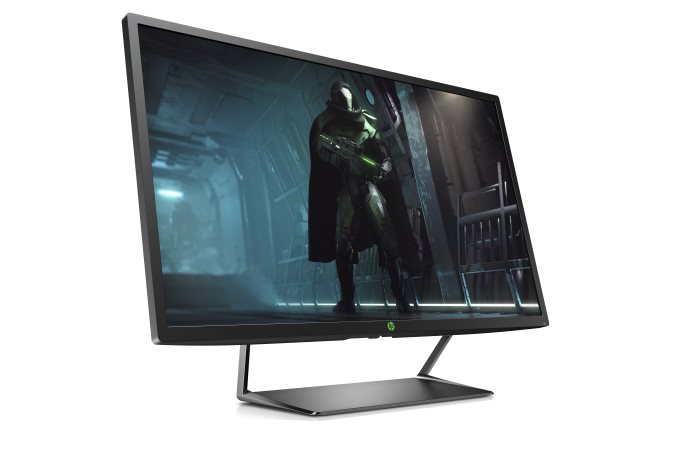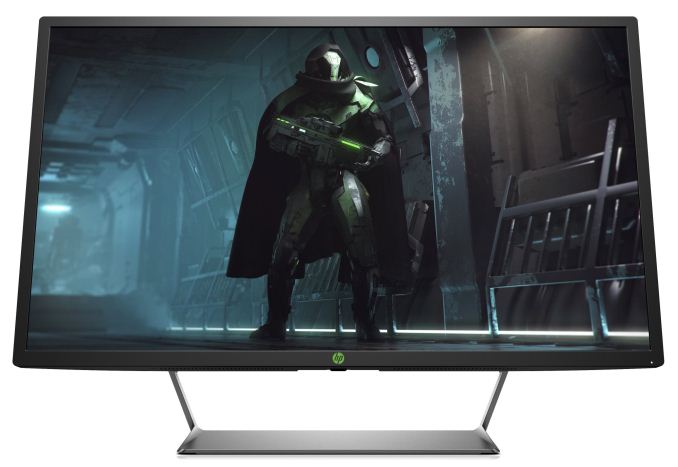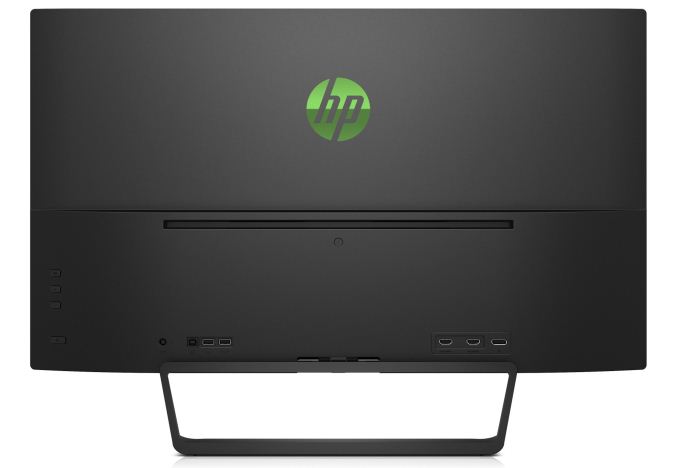HP Announces Pavilion Gaming 32 HDR Display: 32" WQHD w/DisplayHDR 600 & FreeSync
by Joe Shields on April 11, 2018 12:00 PM EST
Alongside their new Pavilion gaming desktops and laptops, today HP is also announcing an addition to their monitor stable with the release of the new Pavilion Gaming 32 HDR Display. An update of sort to HP's current family of 32-inch monitors, including the existing Pavilion Gaming 32 and Omen 32, HP's latest monitor carves out an important niche for itself by adding basic HDR support.
At a high level, the Pavilion Gaming 32 HDR is built on a 32-inch VA panel featuring a 2560x1440 resolution, 300 nits typical brightness, 3000:1 contrast ratio, 5ms response times, and like many of HP's other 32-inch monitors, is FreeSync (1) enabled. The all-important backlighting system being used to enable HDR is an edge-lit LED system that, like similar systems, supports eight different zones of local dimming for increased contrast.
The chassis of the monitor comes in one color, Shadow Black. About the most identifiable feature is the stand that supports the panel. Instead of a circular base with a single post, HP is using a rectangle shaped base with two posts which should make for more stable footing. The back of the monitor has a large green HP symbol in the middle of its gentle arched rear panel. Still on the rear but at the bottom, we are able to see the power adapter, two USB 3.0 ports, as well as the two HDMI and single DisplayPort ports. On the far left is where the power, menu, and adjustment buttons which leave the front with a clean aesthetic. The only design features on the front is a smaller HP symbol in green in the center of the bottom bezel, as well as the power LED in the bottom right corner.
Officially this is a DisplayHDR 600-certified monitor. This means that it supports limited/mid-tier HDR features, including 600 nits peak luminescence for brief periods of time. HP rates the typical brightness at just 300 nits, though as a DisplayHDR 600-compliant display it should be able to sustain 350 nits indefinitely. Equally important, on the color gamut side, the DisplayHDR requirements mean that this monitor needs to support DCI-P3, with HP going above and beyond the standard with a 95% DCI-P3 color gamut.
Meanwhile, to earn its gaming credentials, the monitor supports AMD's first-generation FreeSync variable refresh technology. The 48Hz to 75Hz refresh rate isn't quite wide enough to support FreeSync low framerate compensation, but along with allowing at least some variability here, the higher-than-average 75Hz refresh rate does give the monitor an edge in smoothness over standard 60Hz monitors. This also puts the Pavilion Gaming 32 HDR in limited company as it offers both HDR and FreeSync support. Notably, however, this is not a FreeSync 2 display, so it doesn't get to take advantage of AMD's latest technology there.
The HP Pavilion Gaming 32” Display will cost $449 and will be available through HP.com and other retailers such as Amazon on May 11th.
| Specifications of the HP Pavilion Gaming 32 HDR | |
| 3BZ12AA#ABA | |
| Panel | 32" VA |
| Native Resolution | 2560x1440 (WQHD) |
| Refresh Range | 48 -75 Hz |
| Response Time | 5 ms GtG |
| Brightness | 300 cd/m² (typical) 600 cd/m² (peak) |
| Contrast | 3000:1 |
| Viewing Angles | 178°/178° horizontal/vertical |
| Pixel Pitch | 0.276 mm² |
| Pixel Density | 91.8 ppi |
| Display Colors | 16.7 million |
| Color Gamut Support | DCI-P3 95% |
| Inputs | 1 × DisplayPort 2 × HDMI HDCP 1.4/2.2 |
| Stand | Tilt angle: 21° up; 5° down |
| Audio | N/A |
| VESA | 100 × 100 |
| Additional Information | N/A |
Related Reading:
- Dell's Spring Range: New 8th Gen Alienware, Laptops, and Monitors
- LG Introduces New UltraFine 4K and 5K Monitors
- HP Z27q Monitor Review: Aiming For More Pixels
- LG Announces the 5K UltraWide 34WK95U: A 'Nano IPS' Monitor with a HDR600 Badge
- LG Develops ‘Nano IPS’ LCD, Unveils 32UK950 4K Display with DCI-P3, HDR600, TB3
- Dell Previews 27-inch ‘5K’ UltraSharp Monitor: 5120x2880
Source: HP












46 Comments
View All Comments
Lolimaster - Wednesday, April 11, 2018 - link
Thing is 32+ is just too big for PC monitor. I tried using my 40" 1080p as monitor (res aside) it feels weirg.zodiacfml - Friday, April 13, 2018 - link
If your TV is 4K, it is not weird. I'm using a 43" 4K LG now and doesn't feel enormous. Now I want something bigger but couldn't justify the price increase from 43".rtho782 - Wednesday, April 11, 2018 - link
Also, 48-75hz, so no LFRC... meh.kpb321 - Wednesday, April 11, 2018 - link
A 32 inch 1440p monitor like this is going to be roughly the same dpi as a 24 inch 1080p monitor so definitely not a High DPI monitor but not horribly bad either. If you just want something bigger than you currently use that doesn't make things smaller then this might be what you are looking for.Zoomer - Friday, March 15, 2019 - link
Would take 2560x1600 over 4k for a 32 inch desktop screen.Valantar - Wednesday, April 11, 2018 - link
I'm quite amazed at how long it's taking for a panel that checks all the key boxes of my Dream Monitor spec. This has some good sides (contrast, HDR, gamut, design), and the price is great, but falls flat on others. An external power brick? That's a deal breaker for me alone.Still waiting for a 34" 21:9 1800r curved 3440*1440 ~100Hz HDR wide-gamut (and reasonably calibrated) FreeSync (2 would be lovely) monitor with an internal PSU and a VESA mount (and preferably a 4+ port USB hub). Until I can get that (features in parentheses are kinda optional), my U2711 stays where it is.
Morawka - Wednesday, April 11, 2018 - link
lol, the power brick's a deal-breaker... get out of here with that nonsense. External bricks keep the monitor slim, easier to move around when on a swivel stand. Plus if the monitor company cheaps out on the PSU (most do) you can always buy a upgraded pack, not to mention fast replacement.DanNeely - Wednesday, April 11, 2018 - link
Depends what he's doing that he needs a Vesa mount. A wall mount or long monitor arms (an articulated floor stand) could result in a brick suspended in mid air. At best that can be kludged around by ziptieing the brick in place somewhere on the arm itself to keep it from moving, but that'd be kinda ugly and defeat the looks elegant bit that arms are supposed to give (along with their various functional benefits).Valantar - Thursday, April 12, 2018 - link
Yeah, 'cause what I want to do when I buy a $1000 monitor is to immediately buy a new power brick for it. Right. That makes sense.Internal PSUs force OEMs to use high quality units as they'd fail prematurely and cause expensive RMA hell otherwise. Also, as you say, they're highly likely to cheap out on the external units, and they will invariably fail (but cause far less of a hassle for the maker as they're easier to RMA). Not to mention that thin DC power leads are fragile and break easily, as opposed to bog-standard, easily replaceable, cheap and far more durable AC cords. Oh, and then there's the damn brick, more than negating any good sides of monitor slimness by laying on the floor and making a mess with meters of excess cabling, or conversely dangling around due to too-short cables. Far more difficult to clean up and manage.
As for keeping the monitor slim, that depends on how good/bad/lazy/cheap the design team are - there are plenty of slim-enough monitors with internal PSUs. I don't care about absolute slimness, as I'm not likely to be looking at my monitor from the side much.
When it comes to "easier to move around", that depends on cable management. Sure, if you don't do that, slim DC cables are nice. If you do it properly, it doesn't matter unless you're frequently pivoting your monitor - swiveling doesn't (at least in my case) cause enough movement to be a problem.
Arguments for external power bricks for monitors are all founded on the premise that it's okay that they suck and that OEMs are betting on people needing replacements quickly (and thus buying them off the shelf rather than RMAing), because off-brand replacements are easy to find. Everything else is a matter of taste and willingness to pay for premium design.
Hurr Durr - Thursday, April 12, 2018 - link
If you have to "move your monitor around" you deserve the brick suffering, twofold.